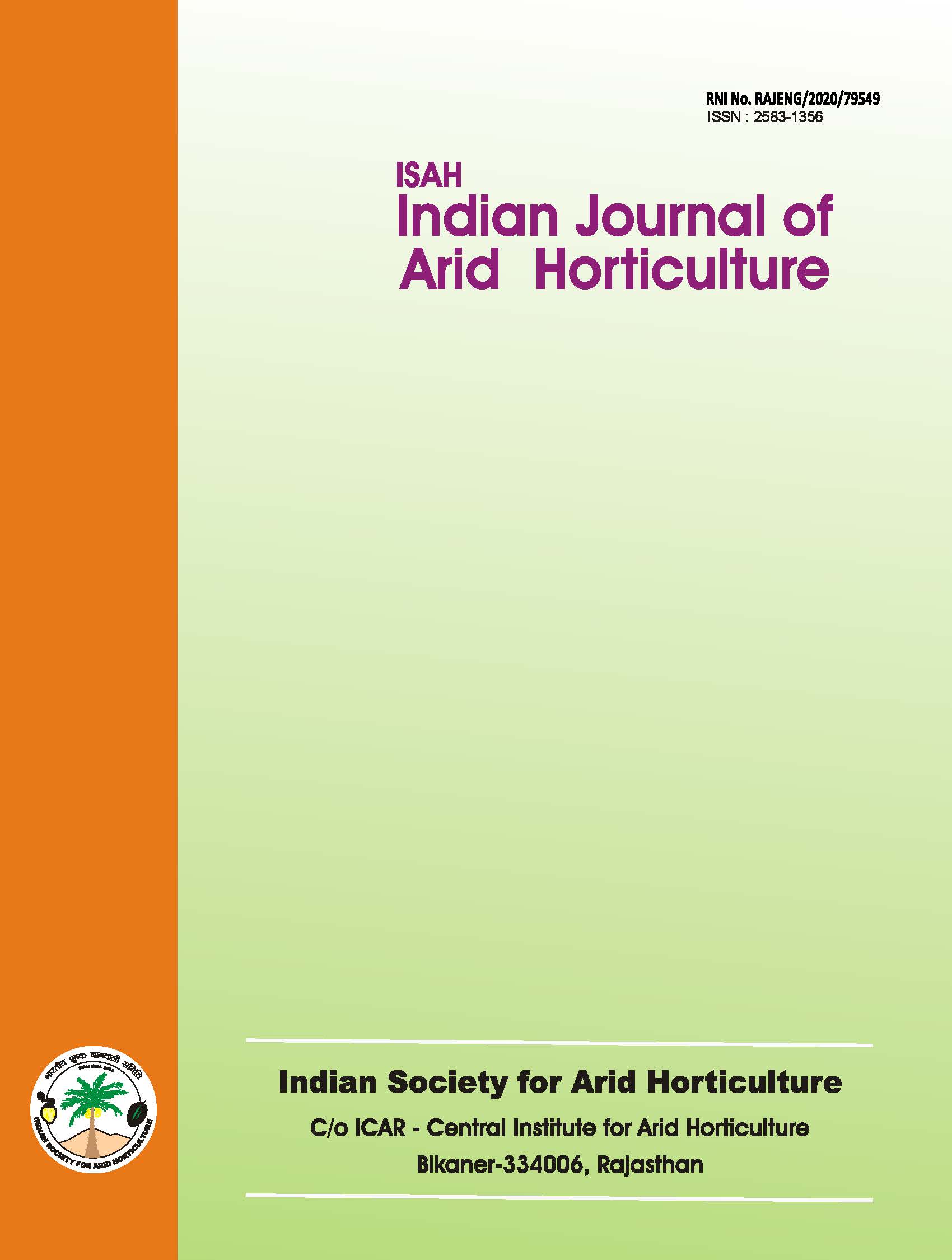Dehydration of karonda (Carissa carandas L.) fruits for culinary utilization
Keywords:
Carissa carandas L, dehydration, fruit powder, organoleptic qualityAbstract
Karonda (Carissa carandas L.) is an underutilized fruit crop of hot arid and semi-arid region grown commonly as a protective hedge. The storage life of karonda is very short because of its soft flesh and high moisture content. Karonda remains unexploited commercially owing to lack of standardized post harvest and value addition technology. Unripe tender fruits (2.0 to 2.5 g) and mature unripe fruits (4.0 to 4.5 g) were subjected to treatments combination consist of control, blanching for 3 minute and blanching with preservatives treatments of potassium meta bisulphite, citric acid and sodium benzoate each at 0.1 and 0.2% concentrations for five minutes and dried in sun. Among all the treatments, tender fruits blanched for 3 minute and treated with sodium benzoate 0.1 % were found superior for dehydration of karonda fruits for preparation of powder. Dehydrated karonda powder was found good in organoleptic taste for its tartness and as masala mixture for its typical sour taste. These dehydrated fruits can also be used as mouth freshener and for making chutney.
Downloads
References
Brewer, M.S., Begum, S., and Bozeman, A. 1995. Microwave
and conventional blanching methods on chemical, sensory and colour characteristic of frozen broccoli. J.Food Qual,18:179-93.
Gupta, S., Lakshmi, J. and Prakash, J. 2008. Effect of different blanching treatments on ascorbic acid retention in green leafy vegetables. Natural Product Radiance, 7(2): 111-16
Hiregoudra, V.S. 2012. Physico chemical characteristics, value addition and shelf life of evaluation karonda (Carissa carandas). M.Sc. Thesis submitted to the University of Agricultural Sciences, Dharwad. Khan, R.M. 2012. Osmotic dehydration technique for fruits preservation A review. Pakistan J. Food Sci., 22(2):71-85. Maheshwari, R., Sharma, A. and Verma, D. 2013. Phytotherapeutic significance of Karaunda. Bull. Environ., Pharmacol. & Life Sci., 1 (12): 34-36. Manivasagan, S., Kumar, S. Rana, G. S. and Joon, M.S. 2007.Study on qualitative changes in pickles
prepared from karonda during storage. Haryana. J. Hort. Sci., 36(2):44-45.
Mayer, A.M. and Harel, E. 1979. Polyphenol oxidases in
plants. Phytochem. 18: 193-215.
Misra, K.K. 2011. Subtropical Fruit Culture, Kalyani
Publishers, New Delhi, pp. 199-223. Mitra, S.K., Pathak, P.K. and Chakraborty, I. 2006.
Underutilized Tropical and Subtropical Fruits of Asia in ISHS Acta Hortic. 770: XXVII International Horticultural Congress - IHC2006: International Symposium on Cultivation and Utilization of Asian, Sub-tropical, and Underutilized Horticultural Crops. Mulay, S.V., Pawar, V.N., Thorat, S.S., Ghate, V.M. and Ingle,
U.M. 1994. Effect of pretreatment on quality of dehydrated cabbage. Indian Food Packer, 48(5):11- 16.
Parvathi, S. and Anby, S. 1997. Karonda delicious. Indian
Hort., 42(1): 11-13.
Ranganna, S. 1997. Handbook of analysis and quality control for fruit and vegetable products. Tata McGraw Hill Publishing Co. Ltd., New Delhi
Saxena, D., Misra, K.K. and Rai, R. 2016. Studies on suitability of cultivars, picking dates and drying methods for the preparation of karonda (Carissa carandus L.) fruit powder. Indian J. Hort., 73(2): 267-273.
Wani, R.A., Prasad, V.M., Hakeem, S.A., Sheema, S., Angchuk, S. and Dixit, A. 2013. Shelf-life of karonda jams (Carissa carandas L.) under ambient temperature. African J. Agric. Res., 8 (21): 2447-49.

